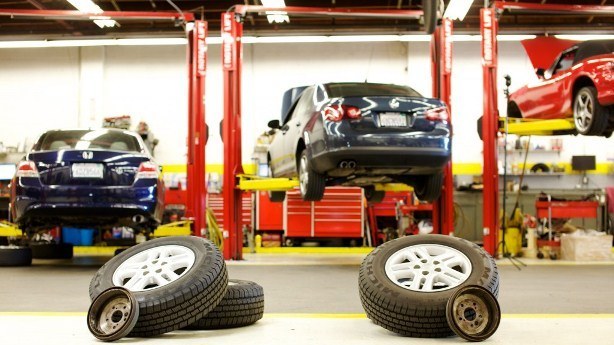All Categories
Featured

Maintaining your automobile's tires is vital to guarantee a smooth, safe, and reliable driving experience. 2 crucial solutions that are commonly forgotten yet have a substantial influence on tire long life and efficiency are tire turning and positioning. These services aid keep your vehicle running effectively and avoid uneven tire wear that can impact both safety and gas economic situation. Allow's dive right into what tire rotation and alignment are and why they are very important for your vehicle.
What Is Tire Rotation? Tire turning is the process of moving your tires from one setting to one more to ensure they put on equally. Because your auto's tires operate at different prices depending on their setting (front tires versus back tires), turning them regularly assists to distribute the wear uniformly, resulting in a longer life-span for your tires.
Tires on the front axle tend to use quicker than those on the rear axle, especially in front-wheel-drive cars, where the front tires manage both guiding and power. On the various other hand, rear tires could wear unevenly depending upon the automobile's weight circulation and driving conditions. By turning your tires every 6,000 to 8,000 miles (or as advised by the supplier), you'll guarantee a more well balanced wear pattern.
What Is Tire Placement? Tire positioning, additionally referred to as wheel placement, describes adjusting the angles of your cars and truck's wheels to the manufacturer's specs. Proper positioning makes certain that your tires are aiming in the right direction, and it assists make the most of tire life and enhance lorry handling. There are three main facets of positioning: camber, caster, and toe.
Camber describes the tilt of the tires from the front of the lorry. If your tires are slanted excessive inward or exterior, it can create uneven wear. Wheel refers to the angle of the steering axis when viewed from the side of the car. This affects the stability of the steering, especially when driving right. Toe refers to the angle at which the tires point internal or exterior when seen from above. This influences exactly how your automobile tracks when driving. An appropriate alignment guarantees that all four tires are directing right in advance and are tilted properly. Imbalance can result from hitting potholes, aesthetics, or simply from the wear of suspension elements in time.
Why Tire Rotation and Placement Issue. Extended Tire Life. Both tire rotation and placement assistance avoid uneven tire wear. When your tires put on uniformly, they last much longer, which can conserve you money in the long run by reducing the requirement for premature substitutes.
Improved Safety And Security. Proper tire rotation and placement improve automobile stability and handling. Misaligned tires or erratically used tires can adversely affect your ability to guide and stop your lorry, specifically in emergency circumstances. Regular upkeep ensures your tires execute ideally, giving a more secure driving experience.
Better Gas Efficiency. If your tires are not aligned properly, they may drag against the road surface, causing resistance. This additional friction can decrease fuel efficiency, triggering your car to consume more gas. Regular tire positioning makes sure that your lorry moves effectively, boosting gas mileage.
Enhanced Comfort. Imbalance or unevenly used tires can lead to a rougher experience, as your vehicle might draw to one side or trigger resonances. By maintaining your tires turned and straightened, you'll take pleasure in a smoother and more comfortable driving experience.
Indications That Your Tires Required Rotation or Placement. It's vital to remain alert for any type of signs that your tires need turning or positioning. Watch out for these typical indications:
Irregular Tire Use: If you observe that a person tire is considerably much more worn than the others, it might be time for a turning or alignment. Guiding Pull: If your vehicle pulls to one side while driving right, this can show imbalance. Resonances: If you really feel resonances in the guiding wheel or the automobile itself, maybe an indication of misalignment or irregular tire wear. Screeching Tires: Uncommon tire noise can additionally show inappropriate alignment or the need for a tire rotation. Exactly how Often Should You Rotate and Straighten Your Tires? Tire turning must typically be done every 6,000 to 8,000 miles or as defined in your lorry's proprietor's guidebook. It's a great idea to turn your tires during every oil change, as this will help you remain on top of routine upkeep.
When it comes to alignment, it does not call for as frequent service. Generally, alignment needs to be inspected at least yearly or whenever you notice issues like drawing away or resonance. You may also require positioning if you have actually struck a large pit or visual, which can toss your wheels out of positioning.
Final Thought: Keep Your Tires in Leading Forming. Tire rotation and placement are essential solutions that maintain your automobile running smoothly, safely, and effectively. By making the effort to have your tires turned and lined up regularly, you're buying your cars and truck's performance and durability, while likewise improving your safety and security on the road. Stay aggressive with tire upkeep, and your car will certainly thanks with much better fuel economic climate, improved handling, and expanded tire life.
Latest Posts
Discover Special Auto Repair Deals in Chicago at Montclare Auto Repair
Uncover the Leading Auto Repair Discounts in Montclare, Chicago
Don’t Miss Limited-Time Auto Repair Specials in Chicago at Montclare Auto Repair
More
Latest Posts
Discover Special Auto Repair Deals in Chicago at Montclare Auto Repair
Uncover the Leading Auto Repair Discounts in Montclare, Chicago
Don’t Miss Limited-Time Auto Repair Specials in Chicago at Montclare Auto Repair
